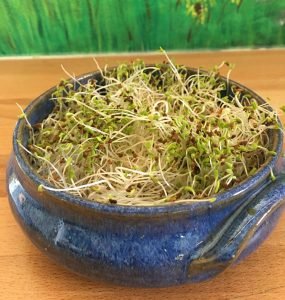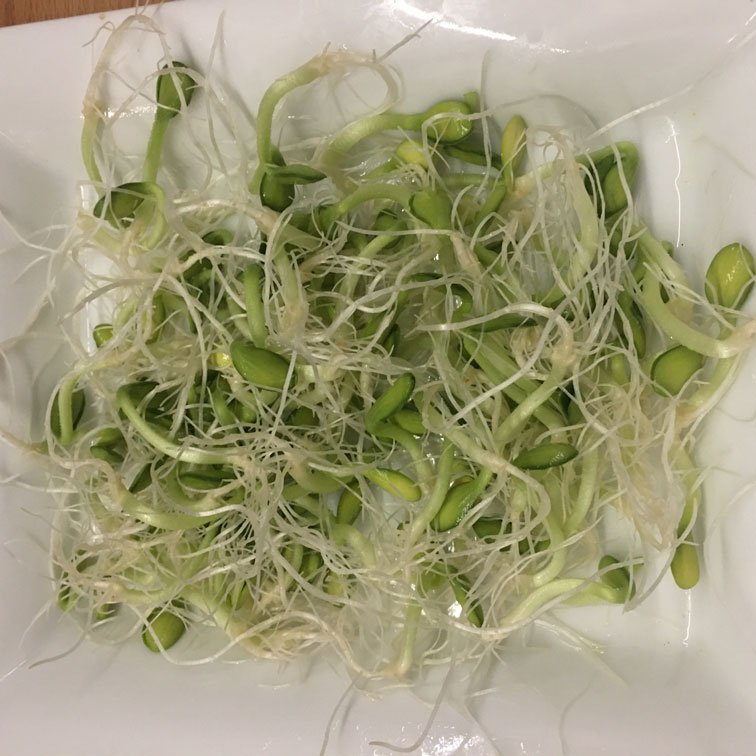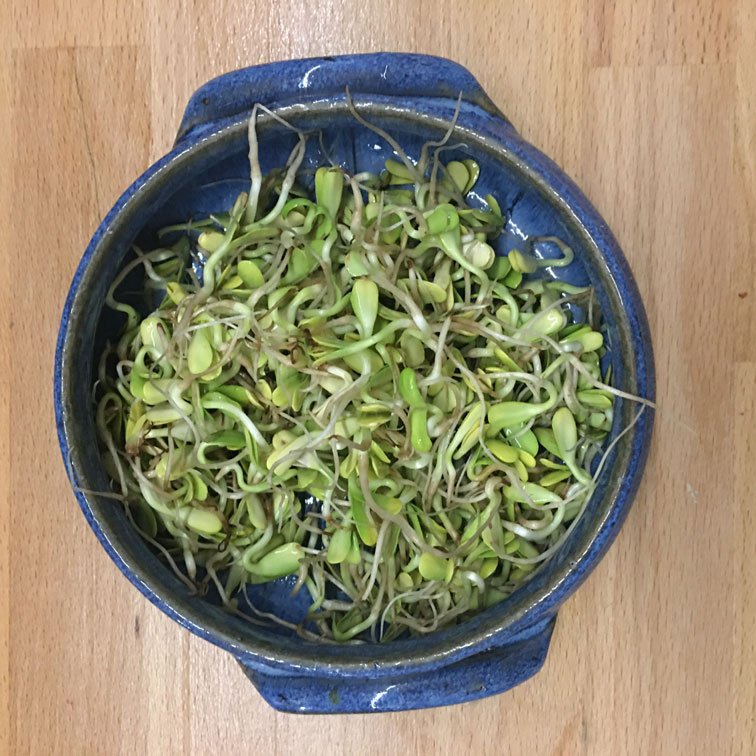Sprouting Seeds for Health: A Guide to Sprouting Seeds at Home
Sprouting seeds at home is an easy and affordable way to incorporate these nutrient-packed grains into your diet. This means you can have an all year round supply of fresh “greens” even without a garden. You will also increase the nutritional value of seeds such as nuts just by sprouting them before you eat them.
So if you live in an apartment or flat or have a very small garden, this is a great way to grow nutritional food at home. In this article, we’ll explore the benefits of sprouted grains and seeds, discuss their nutrition, compare them to whole grains, and provide a guide on how to sprout grains at home.

Sprouted Seeds Benefits
Sprouted seeds are simply grains, seeds or nuts that have begun to sprout. During this process, the seed releases enzymes that break down complex carbohydrates, proteins, and fats into more easily digestible components.
Additionally, sprouting nuts can increase their protein and healthy fat content while reducing their levels of anti-nutrients, which can interfere with the absorption of certain nutrients.
This makes sprouted seeds easier to digest and more nutrient-dense than their unsprouted counterparts. In addition to being easier to digest, sprouting seeds also have a lower glycemic index, meaning they cause less of a spike in blood sugar levels than unsprouted.
Health Benefits of Sprouted Seeds
The benefits of sprouted seeds extend beyond improved digestion and lower blood sugar levels. Sprouted seeds are also rich in antioxidants, which help protect the body against free radicals and reduce inflammation.
They are also a good source of fiber, which promotes healthy digestion and can help lower cholesterol levels. Additionally, sprouted seeds are a good source of vitamins and minerals, including vitamin C, folate, and iron.
Sprouted Seeds Nutrition
Sprouted grains are a nutritional powerhouse. In addition to being a good source of fiber, vitamins, and minerals, they also contain more protein than unsprouted seeds.
Studies have shown that sprouted nuts have significantly higher levels of nutrients such as vitamin C, vitamin B6, folate, and fiber compared to their unsprouted counterparts.
Additionally, sprouted grains are rich in enzymes, which help break down food and aid in digestion.
Sprouted Grains vs Whole Grains
While both sprouted grains and whole grains offer health benefits, sprouted grains have a slight edge in terms of nutrition. As mentioned, sprouted grains are easier to digest and more nutrient-dense than whole grains.
Sprouted grains also have a lower glycemic index than whole grains, which means they are less likely to cause spikes in blood sugar levels. However, it’s important to note that both sprouted and whole grains are a healthy addition to any diet.
Best Grains for Sprouting
Most grains can be sprouted, but some are easier to sprout than others.
Here is a list of grains, nuts, and seeds that can be sprouted and eaten, grouped by type:
Grains:
- Wheat
- Barley
- Oats
- Brown rice
- Quinoa
- Millet
- Buckwheat
- Rye
- Spelt
- Kamut
Nuts:
- Almonds
- Cashews
- Walnuts
- Pecans
- Pistachios
- Macadamia nuts
- Brazil nuts
Seeds:
- Alfalfa seeds
- Broccoli seeds
- Chia seeds
- Flax seeds
- Pumpkin seeds
- Raddish Seeds
- Sunflower seeds
- Sesame seeds
- Hemp seeds
Legumes:
- Lentils (green, brown, red, or black)
- Mung beans
- Chickpeas (garbanzo beans)
- Adzuki beans
- Alfalfa seeds
- Clover seeds
- Soybeans
- Peas (green or yellow)
- Black-eyed peas
- Kidney beans
- Navy beans
It’s important to note that some grains, nuts, and seeds may be easier to sprout than others, and the length of the sprouting process can vary. It’s also important to use high-quality, organic grains, nuts, and seeds to ensure the best possible results.
How to Sprout Grains
Sprouting grains at home is easy and affordable. Here is the basics:

- Choose your grain: Select the grain you want to sprout. Make sure it’s a high-quality, organic grain. Depending on the seed or grain, take about 1-2 Tablespoons (generally for small seeds like alfalfa) or 4-5 Tablespoons for larger nuts. Add to a jar or other receptacle where you can add and cover with water.
- Soak the grain: Rinse the grain thoroughly, then soak it in water overnight.
- Drain the water: Drain the water from the soaked grain. You can buy screw on filters tops for jars, buy a sprouting jar kit or sprouting tray kit. You can also make your own by using an empty jar and using a piece of gauze with an elastic band on the top.
- Rinse the grain: Each day, rinse and drain the grains or seeds once in the morning and once at night. If using a jar, the jar needs to be tilted slightly to allow water to drain. In a sprouting tray, this is not necessary.
- Let them sprout: Leave the container in a cool, dark place. I leave mine the kitchen counter and cover with a cloth.
- Harvest the sprouts: Depending on the time of year, temperature in your room etc, you can have sprouted greens ready (alfalfa for example) in 5 days. Others may take longer.



How to use your sprouted seeds and grains
- Salads: Add sprouted grains to your favorite salad for added texture, flavor, and nutrition.
- Sandwiches: Use sprouted grain bread for your sandwiches or add sprouted grains as a filling for wraps and pitas.
- Buddha bowls: Create a nutritious and colorful Buddha bowl by combining sprouted grains with vegetables, protein, and a flavorful dressing.
- Grain bowls: Make a grain bowl with sprouted grains as the base, then add roasted vegetables, a protein source, and a sauce.
- Breakfast bowls: Create a delicious and filling breakfast bowl with sprouted grains, fresh fruit, yogurt, and honey or nut butter.
- Smoothies: Add a spoonful of sprouted grains to your smoothies for a boost of nutrition and fiber.
- Soups and stews: Add sprouted grains to your favorite soups and stews for added texture and nutrition.
- Energy bars and balls: Make homemade energy bars and balls with sprouted grains, nuts, and dried fruit for a healthy and filling snack.
- Baked goods: Use sprouted grain flour to make bread, muffins, pancakes, and other baked goods.
- Grain-based side dishes: Create delicious grain-based side dishes with sprouted grains, such as sprouted grain pilaf, sprouted grain risotto, or sprouted grain tabbouleh.
These are just a few ideas to get you started. Sprouted grains can be used in a wide variety of dishes, so feel free to get creative and experiment with new recipes!
In conclusion, sprouted grains offer a wealth of nutritional benefits and are an easy and affordable addition to any diet. By sprouting grains at home, you can ensure that you are getting the freshest, most nutrient-dense sprouts possible. So why not give it a try and see how sprouted grains can improve your health and well-being?
